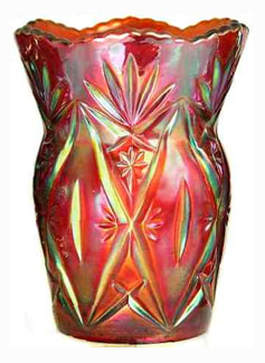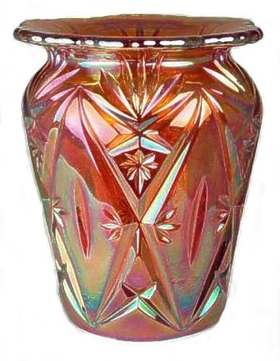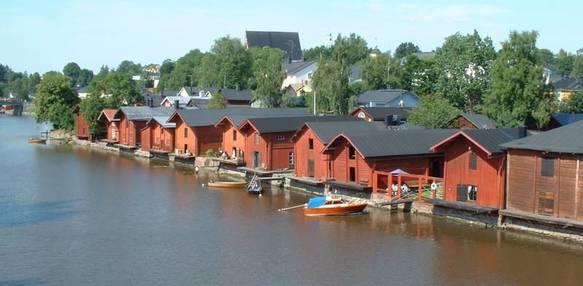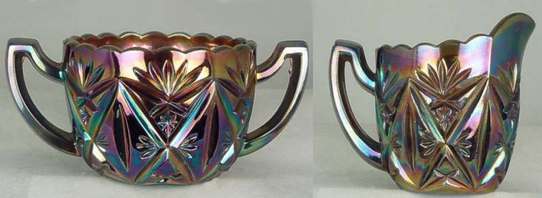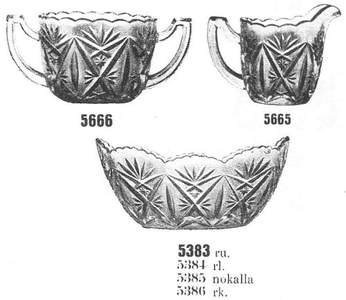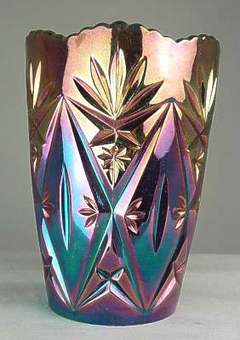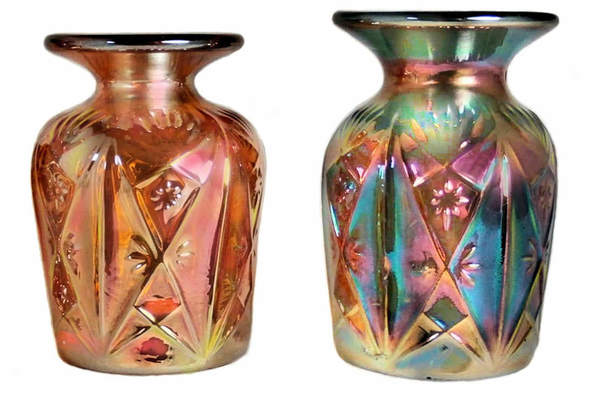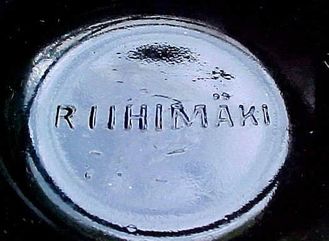The Story Behind The Glass: By Jove! Jupiter by Riihimaki.
Jupiter vases 5½ inches high, in amber.
|
The narrow, cobbled streets of Porvoo’s Gamla Stan (old town) are a delight to stroll along, but it was the antique shop on the corner overlooking the river that really caught our eye.
We’d driven the forty miles in from Helsinki that morning, hoping to find the shop open, but once again, as on a previous visit, the “Closed” sign was up. But wait ... there was also a handwritten note saying that they would open in a few hours. Peering in through the shop windows, we tried to see if there might be any Carnival inside the dark shop interior. At the back of the shop, we thought we could glimpse a tell-tale iridescent gleam, but we couldn’t be sure. We decided to get a coffee from the riverside Porvoon Paahtimo bar and café nearby, and wait … |
Old Porvoo riverside featuring the wooden storage buildings - Creative Commons, photo by SimoM
|
It was a cold morning, and there were a few early drinkers already into the Finlandia Vodka as we took our seats near the wood-burning stove, to enjoy a strong Finnish coffee. Porvoo is a delightful place, so it was no hardship to while away an hour or so. It has a long history, being one of the six medieval towns in Finland, and along the riverside are rows of amazing old warehouses, painted in traditional red ochre.
We finished our coffee and went back to the shop. Still not open! Should we stay or perhaps carry on driving toward Kotka (Karhula)? We chose to wait a little longer, strolling round the other shops and admiring some Russian Faberge style eggs at fancy prices. Back at the antique shop and yes, the owner was just opening up – we followed her inside, eager to see if there might be any Carnival. Our hopes were dashed when the gleam we’d spotted from outside turned out to be lustred porcelain, but then “eureka”! Tucked away on a high shelf at the back of a dark showcase was a tiny little marigold vase. It seemed familiar and yet curiously different. We watched as our little prize was carefully wrapped and we left the shop elated yet a little puzzled.
It was a cold morning, and there were a few early drinkers already into the Finlandia Vodka as we took our seats near the wood-burning stove, to enjoy a strong Finnish coffee. Porvoo is a delightful place, so it was no hardship to while away an hour or so. It has a long history, being one of the six medieval towns in Finland, and along the riverside are rows of amazing old warehouses, painted in traditional red ochre.
We finished our coffee and went back to the shop. Still not open! Should we stay or perhaps carry on driving toward Kotka (Karhula)? We chose to wait a little longer, strolling round the other shops and admiring some Russian Faberge style eggs at fancy prices. Back at the antique shop and yes, the owner was just opening up – we followed her inside, eager to see if there might be any Carnival. Our hopes were dashed when the gleam we’d spotted from outside turned out to be lustred porcelain, but then “eureka”! Tucked away on a high shelf at the back of a dark showcase was a tiny little marigold vase. It seemed familiar and yet curiously different. We watched as our little prize was carefully wrapped and we left the shop elated yet a little puzzled.
|
Surely the pattern was Riihimaki’s Jupiter, but something was different …
Few Carnival patterns are blessed with the original name given to them by their manufacturer. We are fortunate enough to have a copy of a rare, early Riihimaki catalogue that included the names for a select few of their design ranges. So, when we found the first reported example of this Riihimaki pattern, it was a real pleasure to know we were using the original name for it - Jupiter. It was an interesting choice of name, as the other pattern names were more predictable, using terms for flowers, roses and so on. But Jupiter? A god and a planet; the Romans named the planet after their king of gods, Jupiter, who was also the god of the sky and of thunder (and was, allegedly, pretty handy with a thunderbolt). It’s an intaglio pattern – the stars, fans and long spear shapes (thunderbolts?) are all “cut in” on the surface. Clearly Riihimaki felt that this pattern was one of their top designs, as a wide range of shapes was made, including a table set, ashtray, tumbler, jardinière and vases. The vases are around 5½ inch high and they have a variety of top shapes, including an "as moulded" straight-sided (shown on the right) and ones that were hand finished with a cuspidor or spittoon shaped top and a flared top, both of which are shown at the top of this page. It’s interesting to note that the vases were only illustrated in an early Riihimaki catalogue and are not shown in the more widely known, 1939 catalogue. Most of the other shapes in Jupiter were all present in the 1939 catalogue … but not the vases. |
Wait. Did we say that Jupiter is an intaglio design?
Well, yes we did … but there’s an anomaly. The little vase that we found in the antique shop in Porvoo was undoubtedly the Jupiter pattern, but it was not intaglio, it was CAMEO. The pattern was not incised or “cut into” the surface, it stood up on top. You can see our little vase in the photo below alongside another that we recently acquired. The base glass colour of the first vase we found is actually pale pink, and it has a marigold iridescence. The other is blue. The little pink vase is very small, at only 3½ inches high, while the blue one nudges a fraction higher, as you can see. Each is pinched in at the top (a cuspidor shape). This tiny vase was also illustrated in the early Riihimaki catalogue, in two slightly different versions.
Well, yes we did … but there’s an anomaly. The little vase that we found in the antique shop in Porvoo was undoubtedly the Jupiter pattern, but it was not intaglio, it was CAMEO. The pattern was not incised or “cut into” the surface, it stood up on top. You can see our little vase in the photo below alongside another that we recently acquired. The base glass colour of the first vase we found is actually pale pink, and it has a marigold iridescence. The other is blue. The little pink vase is very small, at only 3½ inches high, while the blue one nudges a fraction higher, as you can see. Each is pinched in at the top (a cuspidor shape). This tiny vase was also illustrated in the early Riihimaki catalogue, in two slightly different versions.
